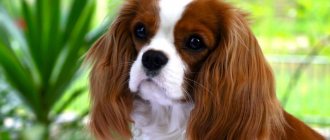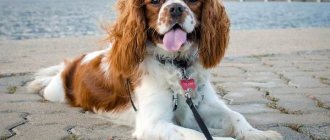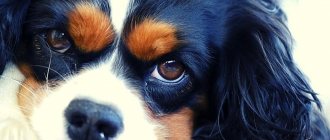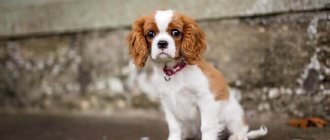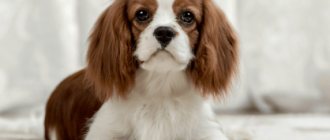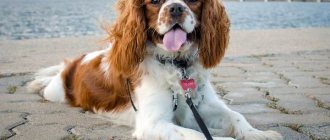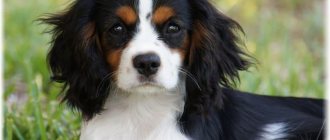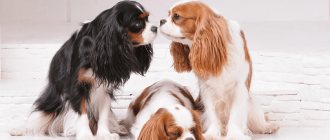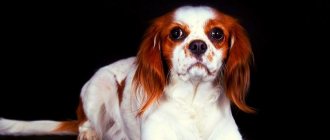Since the 16th century, the Cavalier King Charles Spaniel dog breed has been extremely popular. Then all the noble ladies loved her, and now she rightfully holds the title of king of the dwarf breeds. The kind and affectionate nature of the Toy Spaniel, as he is also called, makes him an ideal family pet.
The future owner will need to not only study the specifics of this breed, but also find out at what price a purebred puppy can be purchased without any “hidden” diseases or other surprises. It is best to contact a nursery where breeding work is carried out, but if you wish, you can also contact a private breeder who has extensive experience in breeding dogs.
History of the Cavalier King Charles Spaniel breed
Cavalier King Charles Spaniel
Due to the similarity of names, the Cavalier King Charles Spaniel is often identified with the King Charles Spaniel. And yet, despite the common Asian ancestor, these are two independent breeds with significant differences in phenotype. Without going into the subtleties of selection, the Cavalier King is a thoroughly “redesigned” King Charles, born as a tribute to British canine traditions. At the same time, Tibetan spaniels are considered the progenitors of both breeds.
Around the middle of the 9th century, the European nobility became interested in the ancestors of today’s “kings” and “cavaliers”. Toy spaniels sat in the boudoirs of baronesses and duchesses, Titian and Van Dyck raced to paint their portraits, and the bloodthirsty tyrant Henry VIII even recognized the animals’ right to be at court. With the accession of Charles II to the British throne, the breed added the prefixes King and Charles to its name and began to enjoy an almost unlimited list of privileges. Why, spaniels were even allowed into the holy of holies - the British Parliament!
The King Charles family began to inevitably fade away with the coming to power of William III of Orange. The new monarch established his own rules at court, settling into his chambers a “party” of pugs, whom he sincerely adored. The rest of the London elite immediately rushed to imitate the preferences of the crowned lady, as a result of which short-faced, bug-eyed dogs came into fashion. Toy spaniel breeders also did not stand aside: in order to please picky aristocrats, they began crossing their own pets with pugs and Japanese chins. Ultimately, by the 20th century, the appearance of the animals had changed so much that only the most sophisticated specialist could recognize the former King Charles dogs in the snub-nosed, big-eyed dogs.
In the mid-20s, European breeders decided to revive the old type of English Toy Spaniels. Around the same time, the British Kennel Club approved a cash prize for the breeder who, within the next five years, manages to breed the classic King Charles variety. As expected, the promise of a reward fueled the interest of breeding specialists, and already in 1928 the first “specimen” of a King Charles Spaniel with a traditional European appearance was presented to the canine commission. The animal had an elongated muzzle and normally set eyes, bringing it closer to the dogs from the paintings of Edwin Landseer.
To avoid confusion in the future, the revived breed was given a new name. Thus, the Cavalier King Charles Spaniel clan branched off from the King Charles tribe. By the way, the prefix cavalier was not chosen by chance. During the English Revolution, this was the name given to supporters of King Charles I, under whom the breed truly flourished. In 1945, the Cavalier Kings were included in the registries of the CC, after which they began to gain popularity in other European countries. The favorites of the British monarchs made their way to Russia even before the revolution, although they began to be fully bred only in 1986.
For your information: over the years, fans of the Cavalier King Charles Spaniel breed have included Ronald Reagan, Johnny Depp, Frank Sinatra, Tary Hatcher, Natalie Wood and Hugh Hefner.
Features of feeding and diet
Cavalier Spaniel nutrition is an important component of the health of a dog of this breed. Dogs are prone to rapid weight gain, gastrointestinal diseases, and allergic reactions to food. If obesity can be “cured” by adding a little more exercise to your pet’s life, then health problems cannot be ruled out. Therefore, for every owner of a four-legged friend, the questions are “what to feed?”, “how to feed?”, “how much to feed?”, “what food to choose?” often become vital.
Feeding a spaniel can contain either natural products or dry food. Is it possible to feed an animal both food and food? Mixing the two types of diets can lead to digestive problems and is therefore strictly not recommended.
Natural nutrition requires the owner to be aware of the pet’s energy needs, the norms for the content of proteins, fats, and carbohydrates in products. Owners who choose this type of nutrition often buy feeding guides for a puppy or an adult dog in order to rely on the diet given in the publication. In addition, the book contains a list of foods allowed for consumption:
- lean red meat (beef);
- poultry meat (turkey);
- rabbit meat;
- low-fat varieties of sea fish;
- offal;
- whole grains (oats, brown rice);
- vegetables (preferably fresh to preserve fiber);
- fruits (except for citrus fruits, pomegranates, overly sweet fruits);
- fermented milk products (low-fat cottage cheese, yogurt, yogurt, kefir);
- vegetable oils.
It is important to monitor the body’s reaction to a particular product and try to eliminate allergy-causing irritants. As a treat, you can give low-fat cheeses and quail eggs. Spicy foods, processed meat products, and baked goods are strictly prohibited.
What food should I feed my dog? After weaning from the bitch, the puppy is switched to food, which he should receive for the first months of his life. After this, the owner can choose another premium food for the four-legged dog, appropriate for its age and health status.
How many times should you feed your pet? The answer to this question depends on the age of the spaniel. A one-month-old puppy receives six meals a day. At the age of five months, the baby is transferred to three meals a day. An adult dog eats twice a day. In all cases, the daily portion of food is divided into the number of meals.
Appearance of a Cavalier King Charles Spaniel
Both King Charles and Cavalier Kings belong to the English Toy Spaniel section, but, as mentioned earlier, have significant differences in appearance. Cavalier King Charles spaniels are larger (from 5.5 to 8 kg) and tall (up to 32 cm at the withers). The dogs' muzzles are moderately elongated, and their eyes lack the protrusion that their relatives inherited from pugs and other Asian breeds.
Cavalier King Charles Spaniel puppy
If the “kings” attract with their pronounced orientalism, then the “cavaliers” – with their unique grace and truly European charm. Silky, straight or slightly wavy fur, sparkling eyes and elegant movements make them ideal pets for all lovers of glamorous breeds. In addition, Cavalier Kings are born fashion models. You can shoot them sleeping, cutting through a dandelion lawn, or sitting in the arms of their owner and not worry about the shot being unsuccessful. These “British aristocrats” are photogenic anywhere, any time and in any mood.
Head
A small, flat skull between the ears with a shallow stop. Cone-shaped muzzle. The distance from the tip of the muzzle to the stop is no more than 3.8 cm.
Ears
The Cavalier King Charles Spaniel has long, high-set ears. The outer side of the ear flap is covered with abundant silky hair.
Eyes
Round, but without noticeable bulge. Large and very dark.
Nose
The lobe is large, uniformly black in color.
Jaws and teeth
Cavalier King Charles Spaniels have powerful jaws with a scissor bite (the lower teeth are completely covered by the upper teeth).
Neck
Normal length, with a slight bend.
Cavalier King Charles Spaniel muzzle
Frame
Compact body with a short lumbar area, flat back and normal chest width.
Limbs
The front and hind legs are moderately bony and smooth. The Cavalier King's paws are miniature, very soft, with the toes almost completely hidden by long dressing hair.
Tail
It is kept at the level of the back or slightly higher. Previously it was docked at ⅓, which is almost never practiced these days.
Wool
Silky to the touch and very long. Straight hair is considered the standard, but slight waviness of the coat is also quite acceptable.
Ruby Cavalier King Charles Spaniel
Cavalier King Charles Spaniel tricolor
Color
The following types of Cavalier King Charles Spaniel colors are officially approved:
- Blenheim (expressive chestnut spots on a white background);
- black and tan;
- ruby (rich red hue);
- tricolor (black with white and tan markings on the eyebrows, cheekbones, back of the legs, ears and under the tail).
Cavalier King Charles Spaniel black and tan
Cavalier King Charles Spaniel Blenheim
Disadvantages and possible defects
All individuals that have deviations from the breed standard are allowed to be considered defective. Of course, most external defects do not block an animal’s access to exhibition events, but the chances of it receiving an excellent mark are reduced to almost zero.
Another thing is developmental defects. A dog found to have them will not be accepted into any dog show. If we talk specifically about Cavalier Kings, they are disqualified for being underweight/overweight, non-standard colors and depigmented nose. Animals with a cleft lip, an atypical bite and an abnormal gait (hackney, ambling) will also have to forget about their exhibition career.
How does pricing work?
There are few factors that influence the cost of a puppy (or the entire litter). A few days later (or before sale), the dog breeder evaluates the entire litter. All young animals undergo strict control and are distributed into the following groups:
Show class
All the most promising puppies that can build an excellent show career acquire “show class” status. They are closest to the breed standard, which means they are more likely to be highly rated by expert judges.
The price for promising puppies is very high and can even reach 100 thousand rubles, regardless of the breed.
Brid class
Most often, this group includes individuals that have minor deviations from the accepted exterior. They are allowed to participate in exhibitions and can even receive good marks. Breed bitches are used for targeted breeding. They are quite capable of producing show class offspring.
Pet class
All young animals are culled from the first days of life. The presence of disqualifying defects, the detection of genetic diseases or pronounced mutations deprive the puppy of a show career. He is purebred and may be branded, but is only suitable as a companion. The pet class has a low price, and the breeder tries to get rid of puppies with pronounced defects as quickly as possible. Such individuals can be bought literally “for pennies.”
The older the puppy gets, the lower the price. Breeders, as a rule, try to sell a young dog faster and may reduce its price.
However, during this time, the grown-up puppy develops its own character and habits, which may be undesirable to the potential owner.
After deciding which type of puppy you are most interested in, you can begin searching for offers in various online resources.
Photo of Cavalier King Charles Spaniel
Character traits
Dogs are tireless optimists. They have an inexhaustible supply of mischief and energy. Dogs are very active and playful up to 2 years old. Adult animals are calmer, but do not lose their enthusiasm until old age.
Attention is vital for gentlemen. Sometimes more than food. They need to constantly communicate with people. If you don’t devote time to your pets, they become picky, capricious, become withdrawn, nervous and fearful. It is advisable to have someone from the family at home at all times.
When a small spaniel lacks attention, he attracts it in his own way. For example, he hides slippers or a remote control. And then, together with the owner, he “searches” for the thing. It's so much fun!
The breed is not vicious and adapts to the lifestyle of its owner. All people are her friends. The pet happily greets family members and strangers. Maybe they'll play with her. And if you’re lucky, they’ll also treat you.
Sometimes pets are stubborn, some of them are possessive. They do not like to share toys and can “take” household items for themselves - plastic dishes, buckets, basins. It is not possible to return items. It's easier to buy new ones.
The dogs bark moderately. They make a voice when guests visit, during games, or if they attract people's attention.
The Cavalier is prone to biting. Usually this is a mistake in upbringing, but the breed has such characteristics. Therefore, grabbing hands and feet with teeth and light biting during play are suppressed.
Personality of the Cavalier King Charles Spaniel
Oh yeah!
Scratchies Cavalier King Charles Spaniels are the best healers of the blues and bad mood. They are literally obsessed with communicating with people and are completely unprepared to play the role of an outside observer in the family in which they live. Despite their generally not the most outstanding dimensions, there are always a lot of “gentlemen” in the house, as they are extremely curious and try to delve into everything that happens not only in front of their eyes, but also behind their backs.
The breed's need for human attention can be slightly annoying to the owner who does not have the opportunity to constantly contact the pet or who is tired of an overabundance of communication with him. That is why breeders recommend Cavalier King Charles Spaniels for large families with several generations of relatives. This will make it easier for the dog to find company without overloading one person with his sociability.
Cavalier King Charles Spaniel with children
Due to his natural curiosity and goodwill, the “gentleman” treats anyone well, even a stranger, so trusting him to guard your own home is obviously a bad idea. Bribing this playful “Englishman” is as easy as shelling pears: just chat gently with him or play a little. Such a feature of the breed as a ringing bark also does little to help the animal in security activities. Cavalier Kings often demonstrate their vocal talents in games than in the case of real danger, so forget about training this glamorous major to be a decent watchman.
In relation to other pets, Cavalier King Charles Spaniels have unparalleled charm. They are completely devoid of leadership ambitions and the desire to dominate everything that moves, so they will gladly hand over the “reins of power” to any four-legged creature that desires it. A purebred “gentleman” will have no problem getting along with another dog, cat or some exotic creature, provided that they do not try to take away his status as everyone’s favorite.
Cavalier King Charles Spaniel with cat
Advantages and disadvantages
Based on the experience of Cavalier owners, one can highlight the pros and cons inherent in the breed, which will help the future owner decide on the desire to purchase just such a pet.
pros
- incredibly dedicated and faithful;
- do not need constant long walks, although if they are accustomed to them they will only be happy;
- the wool is hypoallergenic and does not smell like dog;
- They love children, but are also great for older people;
- get along well with any pets.
Minuses
- they themselves are severe allergy sufferers and have a large list of breed pathologies;
- are often too annoying;
- can afford to bite;
- great owners can “appropriate” any economic item and it will not be possible to take it away.
Photo: pexels.com
Education and training
Cavalier King Charles Spaniels are very smart and easily comprehend all the intricacies of the educational process, which does not prevent them from turning on the “misunderstanding” mode from time to time. Owners often fall for this canine trick and bombard specialized forums with questions like: “Why doesn’t the Cavalier King follow commands?” The reason for this behavior lies not in obstinacy of character, but in banal boredom. Perhaps you simply went too far with the severity and duration of training, tiring the dog. Or they simply did not take into account the peculiarities of her temperament.
Cavalier King Charles Spaniel on a leash
Dog trainers assure that the Cavalier King Charles Spaniel must be trained through play and as affectionately as possible. Most of these British “aristocrats” are characterized by innate timidity, so if you raise your voice during training, your pet may refuse to participate in classes forever. It is also not forbidden to stir up interest in training. For this, a supply of your dog’s favorite treats is enough.
“Cavaliers,” despite their rather gentle and peace-loving character, are not alien to some robber habits at heart. For example, if a dog encounters a cat or rodent on a walk, it will definitely try to chase it. Moreover, not every such “hunt” ends with the happy return of the pet. Captivated by the excitement of pursuit, the Cavalier King can easily get lost, so the commands “Ugh!” and “Nearby!” with a pet should be learned in advance and as firmly as possible.
From the age of 4-5 months, show-class Cavalier King Charles Spaniels begin to be accustomed to the show stand. First, the animal's success is rewarded with a treat. And only after the puppy has formed a stable association: stand = treat, you can use the command “Stop!”
Note: experienced handlers do not recommend teaching the “Sit!” command to the Cavalier King Charles Spaniel. until the animal takes part in exhibition events. Confused in an unfamiliar environment, the pet may confuse the meaning of the commands and, instead of the stance required from it, give the opposite action.
Lover to lie on the sofa
Price of puppies
The price of a puppy will depend on the purpose for which you are purchasing it, so it fluctuates in a fairly wide range. If you want to buy a dog for yourself that will not participate in competitions and exhibitions, then its price will be approximately 600-800 dollars. If you have a goal to acquire a potential champion, then you will need to shell out $1400-1600 for him.
It is best to buy a puppy from a kennel, since there he is provided with proper care and nutrition, as well as all the necessary vaccinations.
Over the course of several centuries, this breed has evolved from a small game hunter to a resident of the royal chambers. Throughout its development, this breed has been around people, so it is ideal for large families, people who work at home, or for retirees, as they will be able to give their pet maximum attention.
Maintenance and care
The first thing that owners of future champions should pay attention to is the flooring materials in the house.
On slippery parquet or laminate flooring, the puppy’s paws will move apart, which will become a prerequisite for the formation of incorrect gait and positioning of the limbs. It is best if the floor in the room is covered with a thick carpet or rugs, since Cavalier King Charles Spaniels are exclusively apartment dwellers. On the street they only walk and go to the toilet. If you sometimes have to leave your pet alone, buy him an enclosure and train him to sit in it. This way, the animal will be deprived of the temptation to chew your shoes or bite computer wires in your absence. Dogs of this breed are transported in cages, to which the pet will also have to be accustomed.
Important: do not use a cage or aviary as punishment in cases where the Cavalier King Charles Spaniel has bothered you too much with its excessive sociability. The dog will quickly realize what the true purpose of this accessory is and will earn itself an additional phobia.
Hygiene
Cavalier King Charles Spaniels are not groomed. You shouldn’t comb them too often either: the fur of representatives of this breed has a silky texture and almost does not tangle. Just brush your baby’s “fur coat” and enjoy freedom from this responsibility for 5-7 days. Another thing is the molting period. At this time, the hair of the “cavaliers” needs daily combing.
Washing a Cavalier King Charles Spaniel
You can smooth the animal's fur with a mitten: this will remove dirt, dust and dander from it. The furry “footprints” left by Cavalier King Charles Spaniels on sofas and carpets are also easy to deal with. Even the most powerful vacuum cleaner can suck up the hair of these dogs without any problems. In addition, the fur of the “Cavaliers” practically does not smell like a dog.
The frequency of bathing a dog is determined by its class. Show animals are washed once a week using a whole arsenal of products to smooth and nourish the hair, as well as giving it a noble shine. For pets, it is enough to give them a bath once a month with shampoo and conditioner to make their fur easier to comb. And don’t forget: the maximum permissible water temperature for a Cavalier King Charles Spaniel is 39 °C. The washed animal is dried with a towel and dried with a hairdryer. It is strictly not recommended to wrap your dog in a diaper and leave it to dry in it. Such experiments lead to dampening of the hair and its subsequent loss.
The most problematic organ of Cavalier King Charles Spaniels is the ears. Due to their hanging position, they are poorly ventilated, but they actively accumulate sulfur and dirt, so it is better to inspect and clean them more often. The pet's eyes should be checked every day, removing debris and mucus that accumulates in their corners with a cotton sponge. For inflammation of the eyes, you can wipe with chamomile infusion. If the inflammation is pronounced, it is not forbidden to drop a couple of drops of albumin onto the mucous membrane. But it is better to completely abandon the tea infusion and boric acid solution, which “home-grown ophthalmologists” recommend using on canine forums.
Representatives of this breed have their teeth brushed twice a week and their nails trimmed once every two weeks. After a walk, the Cavalier King Charles Spaniel's paws must be washed, and in winter they are lubricated with vegetable oil or cream to protect them from the toxic effects of reagents.
Walks
I found acorns for you here
Until 4 months of age, Cavalier King Charles Spaniels are taken for walks as often as possible to teach them to go to the toilet outside. Starting from the 4th month of life, the number of walks is reduced, but their duration is increased. It is important to remember that Cavalier Kings do not need intense physical activity or too long promenades, but simply standing with your pet under a tree will not work either.
It is better to walk the dog in areas where there is no asphalt. There the animal can run properly without the risk of overwork and injury to its paws. If you really want to walk with your “gentleman” on the sidewalks, do not exceed the optimal limit for such walks of 40 minutes.
On a walk
Feeding
“Natural”, “drying” or both – all these types of feeding are considered acceptable for Cavalier Kings. And yet, most experts prefer a natural diet as more healthy. When working on creating a menu for your own pet, keep in mind the fact that the Cavalier King Charles Spaniel is a breed prone to obesity. With an excess amount of high-calorie food, the dog will instantly gain weight, but it will not always be able to lose it.
We are waiting for something delicious!
The necessary products from the point of view of benefits for “cavaliers” are lean varieties of meat, cereals, and low-fat fermented milk. By the way, this breed is very partial to “vegan” dishes, so during the summer season, more often introduce vegetable stews, sliced fruits and salads into your pet’s diet. In addition, many Cavalier Kings readily eat berries, ground cucumbers and zucchini. From time to time it is useful to give dogs a yolk or quail egg.
Prohibited products:
- sweets;
- sausages;
- salty and spicy dishes;
- tubular bones;
- pork and any fatty meats;
- sour cream and cream;
- mushrooms;
- onion and garlic;
- legumes;
- pastries and white bread;
- River fish;
- pearl barley.
Owners who decide to feed their animals industrial food should not forget about the breed’s predisposition to food allergies. In this case, you can protect your pet only by carefully studying the composition of the food, so immediately discard varieties that contain “traces of the presence” of chicken or cereal crops.
This is probably for me
Om-Nom-nom
Toilet
Cavalier King Charles Spaniels are difficult to train to a litter box, so to meet their “needs” representatives of this breed have two options: the street or the diaper. To instill in your pet the habit of going to the toilet during a walk, he is taken outside immediately after eating or sleeping. If the method turns out to be ineffective, you can add a newspaper or a piece of fabric to it, which the dog used “little by little” at home. An animal interested in a familiar smell usually remembers its own needs and sits down next to the wet diaper. Never scold your Cavalier King for puddles in the apartment, but exaggerated praise for the dog for doing its “business” outside the house is very useful.
Feeding
Dog handlers advise choosing dry food as a diet for representatives of this breed. The main condition is that the food be exclusively premium class.
This does not mean that he cannot be fed natural food. The basis of the diet should include:
- meat raw or cooked. It is better to serve beef raw, having cleaned it of veins;
- offal. It is better to give boiled and finely chopped;
- cereals The best option would be rice and buckwheat;
- flax seeds. It is recommended to add to food in order to improve the condition of the coat;
- eggs and dairy products. The norm is two eggs a week, always boiled until hard, 200 grams of cottage cheese and a little kefir.
It's better not to give bones. For these dogs they will do more harm than good, especially for long bones.
Photo: maxpixel.net
Health and Diseases of Cavalier King Charles Spaniels
All hereditary diseases of Cavalier King Charles Spaniels are the end result of so-called line breeding and an overly limited genetic base. The first on the list of ailments that affects about half of the “cavaliers” aged 5 years and older is myxomatous valve degeneration or prolapse. The second scourge of the breed is syringomyelia (Chiari syndrome). An animal that has inherited this disease experiences discomfort and severe pain in the cervical spine, which in the absence of timely treatment leads to “twisting of the neck.”
Episodic falling syndrome is more difficult to diagnose than the two previous ailments, which does not prevent it from affecting a huge number of animals. The behavior of Cavalier Kings suffering from this disease is somewhat similar to the habits of dogs that have suffered a back injury. They freeze in place for a long time, arch their back when running and pull up their limbs when lying on their side. Another weak point of the breed is the joints. With age, many "gentlemen" develop patellar instability, and this most often occurs in bitches. Dry eye and curly coat syndromes, which are very difficult to treat, seriously spoil the lives of pets.
Diseases and health problems
Dogs of this breed can live 10 - 12 years on average - a normal period for small breeds. Since the original group that served to develop the breed was small, the hereditary defects inherent in any of them were inherited by many descendants - this phenomenon is known as the “founder effect”.
A heart problem in particular that is all too common in Cavaliers is mitral valve degeneration (MVD). This is the leading cause of premature death in pets. More than half of dogs over 5 years old suffer from this disease and almost all dogs after 10 years. This is 20 times more common than other breeds.
Important fact: When the mitral valve degenerates, heart failure occurs, which leads to fatigue, shortness of breath, increased blood pressure, and pulmonary edema. Cavaliers should be examined by a cardiologist at least once a year, especially since they may have other heart problems.
Another popular disease in Cavaliers is syringomyelia (SM): the formation of fluid cavities inside the spinal cord. Causes neuralgic pain in the neck and chest, the dog becomes restless, lies in an unnatural position, or itches. The reason is considered to be a shortened skull and a violation of the ratio of its parts and brain size, which appeared during selection.
A unique gene mutation causes a specific neurological disorder called episodic falls syndrome. It manifests itself as attacks of “muscle contraction” in different situations. The disease is detected in a genetic test. It was discovered that tricolors carry the vicious gene much more often than cavaliers with even colors.
Also found:
- Hip dysplasia is a congenital disease of different breeds;
- Dislocation of the kneecap;
- Visual impairment: cataracts and retinal dysplasia;
- Hearing impairment, which is common to all spaniels.
How to choose a puppy
When choosing a Cavalier King Charles Spaniel puppy, you can follow the same principles as when buying any other purebred dog.
- Do not take babies from nurseries that are unsanitary and disorderly.
- To insure yourself against purchasing a sick animal, ask the breeder for the results of tests aimed at identifying genetic diseases in the puppy (dry eye syndrome, curly hair, occasional falls).
- The temperament of Cavalier King Charles Spaniels is not gender dependent. Both females and males of this breed are equally affectionate and affectionate to their owner, so choose an animal according to your own preferences.
- Get to know the puppy's parents and their pedigree to avoid purchasing an inbreeding animal (from closely related individuals).
- Choose a playful, inquisitive baby who shows a keen interest in toys. Lethargy and hesitation in Cavalier King Charles Spaniel puppies indicate that they are physically and mentally exhausted.
Features and description
The Cavalier King Charles Spaniel cannot be called homely She is bright, pretty and memorable. Most owners of such an animal literally dote on it. And this is not surprising. It has an attractive charisma. It is interesting that despite the dog being classified as a spaniel, it is completely devoid of hunting potential.
Aggression is not characteristic of him, as well as well-developed observation and a sense of suspicion. Also, the dog cannot boast of excellent adaptation skills. At first glance, it may seem that these are its shortcomings. In fact, dogs without developed working abilities are excellent companions.
Being close to the owner is the main desire of the Cavalier King. He quickly finds a common language with the person who adopted him, as he is characterized by contact and sociability. He happily gets along not only with the owner-leader, but also with other people. He is very happy when guests come to the house.
The dog's homeland is England. Several centuries ago, only aristocrats could afford to have one. Today the situation is the opposite. Yes, a representative of the breed can hardly be called a cheap pet, but it is accessible to everyone.
Breeders insist that he was bred by crossing Pugs with Spitz and Maltese dogs. It's hard to argue with this, because the standardized Charles King does have the genetic traits of all these dogs. He has established himself as a noble and respectable dog. The mistresses of such a favorite often invited artists to the house so that they could depict them on canvas.
The advantage of such a dog was that it always had a calm disposition and could easily sit on its owner’s legs for several hours. The artist did not have to be angry because the pose of the sitters often changed and he had the opportunity to complete the work on time.
The largest population of such dogs is in the USA. There they were especially loved by retired women. The modern representative of the breed is a frequent guest at exhibitions of decorative dogs, as well as at other events dedicated to animals.
Photos of Cavalier King Charles Spaniel puppies
How much does a Cavalier King Charles Spaniel cost?
The cost of Cavalier King Charles Spaniel puppies directly depends on their pedigree and external parameters (class). Domestic breeders have an average price tag for a baby with a veterinary passport and RKF metric - 30,000 - 35,000 rubles. Prices for individuals with a standard appearance, promising to collect all conceivable and inconceivable championship titles in the future, start from 50,000 rubles. Traditionally, the most expensive are puppies from interbreeding (male and female from different countries). Such pets can cost 65,000 rubles and more.
Description of the breed
The main characteristics of spaniels that are “created by a king”:
- the weight of the dog is determined by gender, females are noticeably lighter than males, and is 5-6 kg for girls and 8-10 for boys;
- The height of dogs also depends on gender, the difference is about 10 cm. The size of an adult dog: females grow up to 25 cm, males up to 35 cm at the withers;
- color . With the establishment of a new breed standard, color options took root: four types in total. The first is black combined with beautiful bright tan marks; the second is ruby, so named because in the sunlight this bright red color sparkles like a precious stone; the third is called “tricolor” because it combines black, red, and piebald colors; and, finally, the fourth type - Blenheim - bright red spots with clear outlines stand out on a white-pearl base;
- head _ The muzzle is wedge-shaped, the lips do not droop;
- bite ;
- eyes are round, protruding and shiny;
- ears with elongated hair;
- the body is small but muscular, with a flat back and prominent ribs;
- the tail is in constant motion and is proportional to the body. Sometimes it can be docked by one third of the total length;
- the coat is thick, shiny and very silky;
- life expectancy is from 10 to 15 years.
Photo: wikimedia.org
The difference between a Cavalier and King Charles
Let us note that these two breeds are very closely related historically and, until a certain point in their development, were considered one. In modern conditions, these are two different breeds that differ in a number of ways:
- Nose length. The cavaliers have longer ones, the kings have snub noses;
- Skull shape. For a cavalier it is almost flat, for a king it looks like a dome;
- Bite. The Cavalier has a scissor bite, the King has an undershot bite;
- Size difference. Kings are smaller than Cavaliers.
Photo: sidewaysdogs.com

